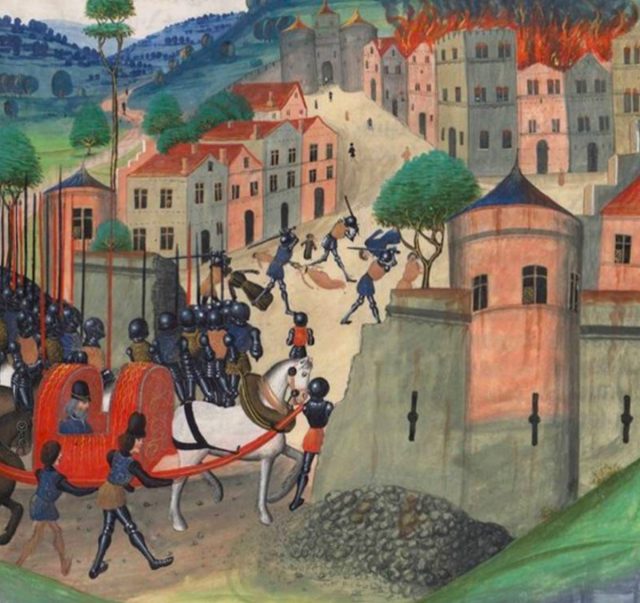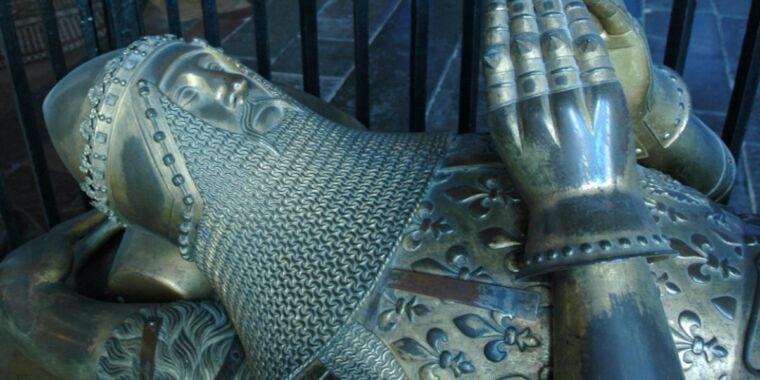
There’s rarely time to write about every cool science-y story that comes our way. So this year, we’re once again running a special Twelve Days of Christmas series of posts, highlighting one science story that fell through the cracks in 2022, each day from December 25 through January 5. Today: A military historian argues that Edward the Black Prince died of malaria and inflammatory bowel disease—not chronic dysentery, as previously believed.
Edward of Woodstock, known as the Black Prince, was a formidable mid-14th century warrior who emerged from multiple battles relatively unscathed—only to be felled by disease at the relatively young age of 45. Historians have long believed he died of chronic dysentery, but James Robert Anderson, a military historian with 21 Engineer Regiment, believes the Black Prince was more likely brought down by malaria or inflammatory bowel disease. He and his co-authors made their case in a short December paper published in the journal BMJ Military Health.
“There are several diverse infections or inflammatory conditions that may have led to his demise,” Anderson et al. wrote. “These might include malaria, brucellosis, inflammatory bowel disease, or long term complications of acute dysentery. However, chronic dysentery is probably unlikely.”
As we’ve reported previously, Edward of Woodstock was the eldest son of King Edward III and heir apparent to the throne. He was educated in philosophy and logic and well-trained in the art of war—skills that proved useful in this particular period of the Hundred Years’ War, when invasion by the French was a constant threat.
Edward’s first foray into battle was at the vanguard of the famous Battle of Crécy in 1346, when he was just 16. Beset by a dangerous counterattack, the young knight sent word to his father requesting reinforcements. Edward III declined the request, insisting he wanted his son to “prove his spurs” in battle. The young prince prevailed, launching an impressive military career. One of his biggest victories was the 1356 Battle of Poitiers, where he and his men routed the French army and captured King John II of France.
Historians disagree about how he came to be called the Black Prince. The first known reference to Edward as the Black Prince is in two manuscript notes by the 16th-century poet and historian John Leland. Shakespeare refers to him as “that black name, Edward, Black Prince of Wales” in Henry V, written circa 1599, and includes a reference in Richard III (circa 1595). So the moniker was well established by the end of the 16th century.
One popular theory is that Edward wore black armor into battle; there is one French account describing him as being clad en armure noir en fer bruni (“in black armor of burnished steel”). But otherwise, the evidence for this is scant. The other hypothesis is that the name derives from Edward’s well-documented reputation for brutality in battle. In England, of course, he was lauded as the epitome of noble chivalry, but the French in Aquitaine held a very different view.
Edward’s health declined rapidly once he returned to England in 1371. He died on June 8, 1376, at the Palace of Westminster. Historians have long held that he suffered from violent dysentery and sometimes fainted from the attacks. There are accounts of dysentery dating all the way back to Hippocrates, sometimes called the “bloody flux” because the main symptom is bloody diarrhea—usually accompanied by fever and abdominal pain, and often leading to dehydration. Dysentery was rampant in the Middle Ages, felling multiple monarchs: Henry the Young King (1183), John, King of England (1216), Louis IX of France (1270), Edward I of England (1307), Philip V of France (1322), and Henry V of England (1422).
The Black Prince’s illness emerged following his victory at the Battle of Najera at the beginning of summer in 1367, according to the authors. Historical accounts indicate that as much as 80 percent of Edward’s army may have died from dysentery and other disease, after enduring significant hardships and hunger during the campaign. He is described in 1370 as “lying sick in his bed” and having to be carried in a litter to direct the Siege of Limoges. He had recovered sufficiently to board a ship for his final military campaign in 1372, but doesn’t seem to have been active during 1374-1375, suggesting his symptoms may have reappeared.

Bibliothèque nationale de France
Amoebic dysentery often leads to chronic complications like colitis, toxic mega-colon, and colonic ulcers, which would be consistent with Edward’s recurrent illness and drawn-out decline. But Anderson et al. argue that it was unlikely he would have been allowed to board that ship in 1372 with chronic dysentery, citing a 2009 review article suggesting a fistula, nephritis, or cirrhosis (or a combination thereof) as alternative diagnoses. Complications from acute dysentery might fit the bill, however.
Other possibilities include dropsy, known today as a swelling under the skin (edema) often related to liver, heart, or kidney failure, but Anderson et al. think Edward would have been unlikely to survive for several years without treatment. It’s more likely that dehydration from the Spanish campaign may have led to kidney stones. Inflammatory bowel disease also fits the pattern of the Black Prince’s illness, particularly if it led to a painful fistula.
Alternatively, Edward may have suffered from brucellosis, a bacterial infection usually contracted by consuming unpasteurized dairy or raw meat, resulting in fatigue, recurrent fever, and inflammation of the heart and joints. Malaria would also fit the fluctuating nature of the prince’s illness, and its symptoms (fever, headache, myalgia, gastrointestinal distress, chronic anemia, fatigue, and increased vulnerability to infection) can lead to multiple organ failure.
Regardless of the cause of death, Edward’s untimely passing changed the course of English history, triggering more than a century of instability. His father died the following year (1372), and Edward’s 10-year-old son ascended the throne as Richard II. Richard II, in turn, was deposed in 1399 by the exiled Henry Bolingbroke—son of the Black Prince’s younger brother, John of Gaunt, and another grandson of Edward III—who became Henry IV. The 15th century brought the Wars of the Roses, with infighting between two branches of the House of Plantagenet (Lancaster and York) essentially wiping out the male heirs in both lines, leading to the rise of the House of Tudor.
“Even in modern conflicts and war zones, disease has caused enormous morbidity and loss of life, something that has remained consistent for centuries,” Anderson et al. concluded. “Efforts to protect and treat deployed forces are as important now as in the 1370s.”
DOI: BMJ Military Health, 2022. 10.1136/military-2022-002282 (About DOIs).








